NVIDIA GeForce GTX 670 Review Feat. EVGA: Bringing GK104 Down To $400
by Ryan Smith on May 10, 2012 9:00 AM ESTAs always, we’re wrapping up our look at a video card’s stock performance with a look at power, temperature, and noise. As GTX 670 is a lower clocked, lower power, harvested version of GK104, it should do even better than GTX 680 here. Remember, the power target for GTX 670 is only 141W.
| GeForce GTX 600 Series Voltages | |||||
| Ref GTX 670 Boost Load | EVGA GTX 670SC Boost Load | Ref GTX 680 Boost Load | Ref GTX 670 Idle | ||
| 1.175v | 1.162v | 1.175v | 0.987v | ||
Stopping to take a quick look at voltages, we find that NVIDIA hasn’t really adjusted the voltages of GTX 670 compared to GTX 680. Because GTX 670 has a lower maximum boost bin than GTX 680 it ramps up to 1.175v a bit sooner, but otherwise it’s still covering the same range of voltages as opposed to having a lower max voltage to further improve the power consumption. EVGA however does just that, topping out at 1.162v. They’ll need all the power savings they can get since power consumption is inversely proportional to performance under NVIDIA’s power target system.
On that note before we jump into our graphs we wanted to try something new: a look at the average core clockspeed during our benchmarks. Because of GPU boost the boost clock alone doesn’t give us the whole picture – particularly when also taking a look at factory overclocked cards – we’ve recorded the clockspeed of our GPU during each of our benchmarks when running them at 2560x1600 and computed the average clockspeed over the duration of the benchmark.
| GeForce GTX 670 Average Clockspeeds | ||||
| GTX 670 | EVGA GTX 670SC | |||
| Max Boost Clock | 1084MHz | 1188MHz | ||
| Crysis | 1057MHz | 1079MHz | ||
| Metro | 1042MHz | 1066MHz | ||
| DiRT 3 | 1037MHz | 1062MHz | ||
| Shogun 2 | 1064MHz | 1105MHz | ||
| Batman | 1042MHz | 1075 MHz | ||
| Portal 2 | 988MHz | 1034MHz | ||
| Battlefield 3 | 1055MHz | 1080MHz | ||
| Starcraft II | 1084MHz | 1129MHz | ||
| Skyrim | 1084MHz | 1113MHz | ||
| Civilization V | 1038MHz | 1073MHz | ||
| OCCT | 953MHz | 980MHz | ||
In spite of the GTX 670’s boost clock of only 980MHz, we see that it spends almost its entire time above that, and indeed spends its whole time above the base clock. As far as games go, with the exception of Portal 2 it’s always in the mid-1000s, whereas the GTX 680 was only a bit higher at the high 1000s. This is a big part of why the GTX 670 has performed so well in our tests: it may be rated lower, but in fact it can reach clockspeeds very close to the GTX 680.
At the same time this is why we see the EVGA GTX 670 Superclocked struggle to separate itself from the reference GTX 670, in spite of a 6%+ factory overclock. Too much of the time it’s simply not boosting much higher than the reference GTX 670, which limits the performance gains. With GPU Boost in effect this means there are a range of cards and we could be looking at a particularly good reference GTX 680, but whether that’s the case or not the end result is that EVGA’s card can’t do too much amidst the 141W power target limit.
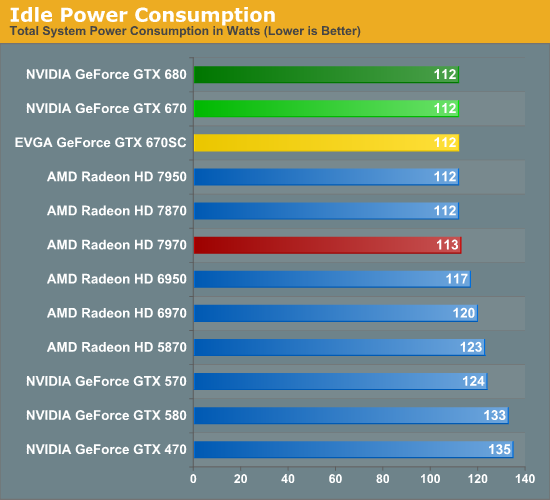
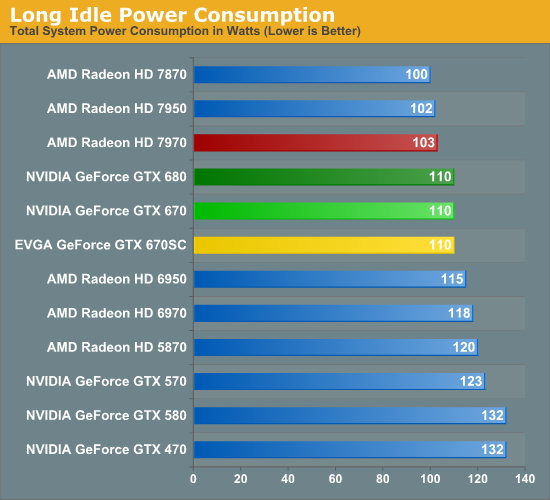
Starting with idle power, there aren’t any major surprised compared to the GTX 680. NVIDIA and AMD have both done such a good job managing their idle power consumption that even with the disabled SMX there’s no measurable difference between video cards. GTX 680 and GTX 670 effectively have the same idle and long idle power consumption.
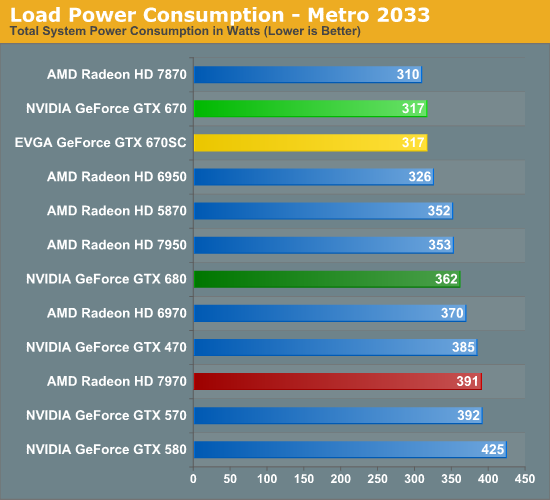
Moving on to load power consumption we can immediately see the GTX 670’s lower power target come into play. At 317W from the wall it’s 45W less than the GTX 680 for roughly 90% of the gaming performance, and this is in fact is lower power consumption than anything except the Radeon HD 7870. Even the GTX 560 Ti (which isn’t in this chart) is higher at 333W, reflecting the fact that GK104 is the true successor to GF114, and which would make GTX 670 the successor to GTX 560 from a design perspective.
Of course this also means that GTX 670 does very well for itself compared to AMD’s cards. We saw GTX 670 slightly outperform 7950 in Metro and here we see it drawing 36W less at the wall at the same time. Or compared to the 7970, 7970 can outperform GTX 670 by about 10%, but we’re drawing 74W more at the wall as a result.
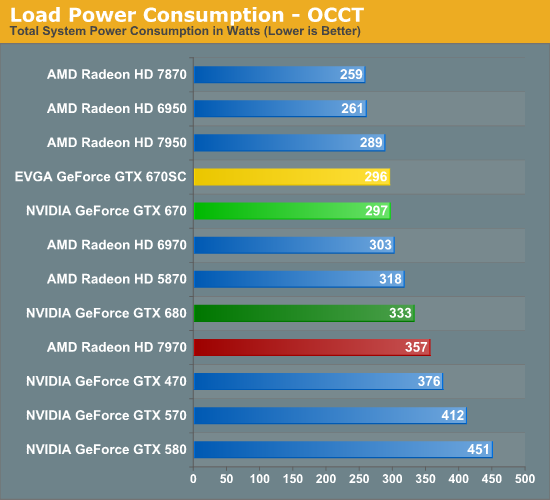
Relative power consumption shifts slightly under OCCT, but the story is otherwise similar. It’s not immediately clear why GTX 670’s power consumption is slightly higher than 7950 even after what we saw with Metro (PowerTune should be capping at 200W), but at least in this test the GTX 670 does end up doing a bit worse. On the other hand it’s still 60W less than the 7970.
Otherwise if we compare the GTX 670 to the GTX 680 we see that the GTX 680 ends up drawing 36W more at the wall, only a bit less than the difference we saw under Metro and quite close to what we’d expect based on the cards’ specifications.
On a related note, pay close attention to NVIDIA’s power target system in action here. In spite of the fact that the GTX 670SC is a binned part running at a lower voltage and higher clockspeeds, it’s drawing 1W less than the reference GTX 670. It would appear that NVIDIA has very good control over their power consumption overall, even if they can only adjust clocks for it a few times per second.
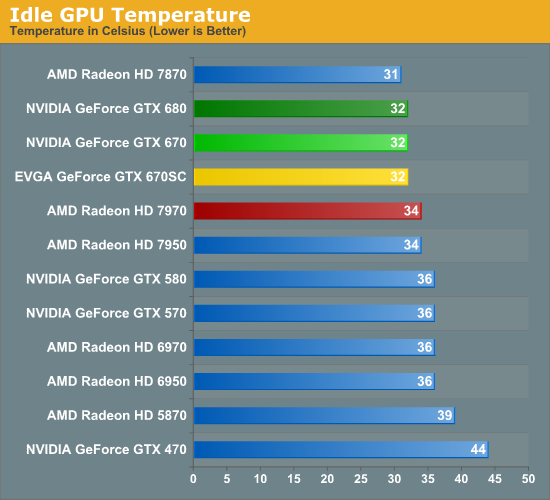
Seeing as how NVIDIA is using roughly the same cooler design with GTX 670 as they are with GTX 680 and they have the same idle power consumption, it should come as no surprise that temperatures are so similar. 32C is among the lowest of the temperatures we’ll see for a blower unless it’s running fast & loud.
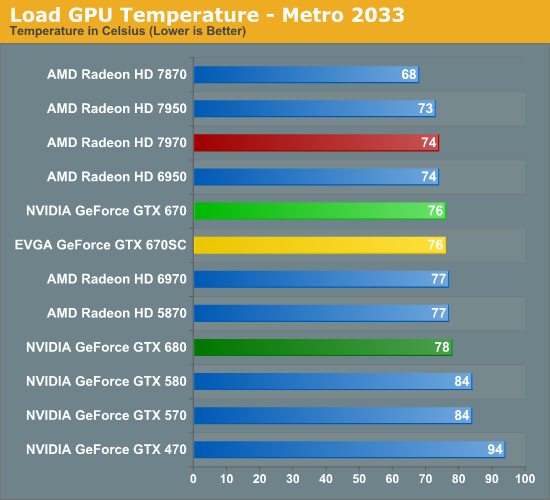
Thanks to the lower power consumption of the GTX 670 temperatures have gone down as well. 76C is still 2C warmer than the Radeon HD 7900 series due to AMD’s more aggressive cooler but it’s 2C cooler than the GTX 680. The thermal threshold for GK104 is 98C, which means there’s still over 20C of thermal headroom to play with here.

OCCT pushes temperatures up some, but not by much thanks to NVIDIA’s power target system. Since the GTX 680 tied the 7970 at 79C here, this means the GTX 670 is 2-3C cooler than both the GTX 680 and the 7970, and 0-1C warmer than the 7950.
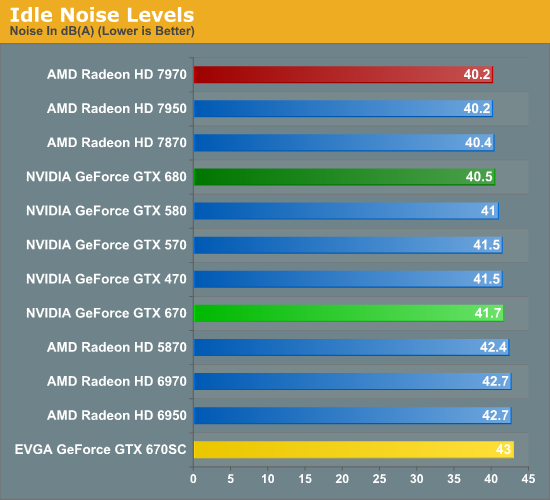
Unfortunately the impressiveness of the GTX 670 begins to wane some here at noise. NVIDIA tells us that the GTX 670 uses the same fan as the GTX 680 but this seems questionable. 41.7dB is not significantly louder than the GTX 680’s 40.5dB, but there’s a definite difference in pitch compared to the GTX 680. The GTX 670 seems to have a low pitch hum/grind to it that GTX 680 didn’t have.
Meanwhile EVGA’s card fares the worst here, at the precipice of falling out of the quiet zone. Since it’s using what’s fundamentally the same fan and cooler as the reference card, the only practical explanation is that EVGA’s smaller diameter fan intake has a negative impact on fan noise.
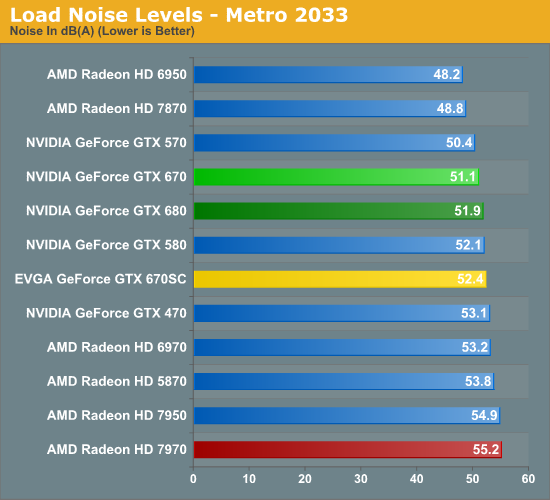
Finally, when looking at load noise we see that the GTX 670 doesn’t fare significantly better or worse than the GTX 680 here. At 0.8dB quieter than the GTX 680 the GTX 670 is a smidge quieter, but it’s nothing that’s particularly appreciable. Perhaps the more important fact is that this is 3.8dB quieter than the 7950 and 4.1dB quieter than the 7970, making the GTX 670 notable quieter than either 7900 series card. In practice the only place the GTX 670 loses is oddly enough to the GTX 570. The GTX 570 was 0.7dB quieter than the GTX 670 despite the former’s much higher power consumption. NVIDIA did let the GTX 570 get hotter than the GTX 670 so it looks like the GTX 670’s fan curve is a bit more aggressive than the GTX 570’s.
As for the EVGA GTX 670 Superclocked we’re seeing the same thing that we saw at idle: it’s just a bit louder than the reference GTX 670. This is in spite of the fact that the GTX 670SC’s fan actually went to the same speed as the reference GTX 670’s fan in this test.
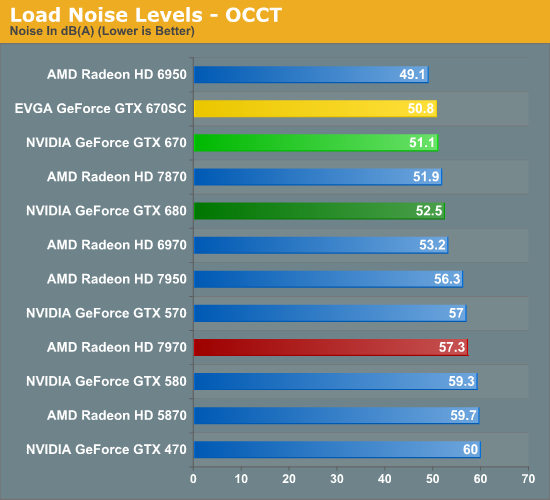
NVIDIA’s power target once more makes itself known here, thanks to which power consumption and thereby heat generation increases very little compared to what we saw under Metro. This widens the gap between the GTX 670 and 7900 series, which is now at 5.2dB and 6.2dB compared to the 7950 and 7970 respectively. Or compared to NVIDIA cards this is 1.4dB quieter than the GTX 680 and nearly 6dB quieter than the unthrottled GTX 570.
Meanwhile there’s something very interesting going on with the GTX 670SC that’s a wider reflection of the GTX 670’s reference fan. The fan speed went up but objective noise (A-weighted) went down. Why? That low-pitch hum we mentioned diminishes with a higher fan speed, and as a result the fan gets quieter once it passes a certain threshold. Subjectively we agree with our sound meter: the GTX 670SC sounds quieter here than it does as the lower fan speed it uses for cooling during Metro. We haven’t experienced anything like this with the GTX 680, which makes us further doubt that the fans are identical between the GTX 680 and GTX 670. Close no doubt, but not the same.
Wrapping things up this entire scenario is very similar to how we saw the launch of the GTX 680 play out. NVIDIA has a strong performing part with less noise and less power consumption than either its 500 series predecessors or AMD’s closest competition. This in turn was a big part of what made the GTX 680 so easy to recommend, as better performance with less noise is exactly the kind of direction we like to see video cards move in.










414 Comments
View All Comments
SlyNine - Saturday, May 12, 2012 - link
No the 5870 was replaced by the 6970. The 5870 was faster then the 6870.The wall was coming, since the 9700pro that needed a power adapter, to videocards that need 2 power adapters and took 2 slots. That was how they got those 2 and even 4x increases. the 9700pro was as much as 6x faster then a 4600 at times.
But like I said this wall was coming and from now on expect all performance improvements to be based on architecture and node improvements.
CeriseCogburn - Sunday, May 13, 2012 - link
My text > " 4890-5870-6970 ???? "It was a typo earlier, dippy do.
9600pro was not 6X faster than a 4600 ever, period - once again we have your spew and nothing else. But below we have the near EQUAL benchmarks.
http://www.anandtech.com/show/947/20
http://www.anandtech.com/show/947/22
6X, 4X, 2X your rear end... another gigantic lie.
Congrats on lies so big - hey at least your insane amd fanboy imagination and brainwashing of endless lies is being exposed.
Keep up the good work.
Iketh - Thursday, May 10, 2012 - link
do you listen to yourself? you're just as bad as wreckage....you have never and will never run a corporation
CeriseCogburn - Thursday, May 10, 2012 - link
How can I disagree as obviously you are another internet blogger CEO - one of the many thousands we now have online with corporate business school degrees and endless babbling about profits without a single price cost for a single component of a single video card discussed under your belts.It's amazing how many of you tell us who can cut prices and remain profitable - when none of you have even the tiniest inkling of the cost of any component whatsoever, let alone the price it's sold at by nVidia or amd for that matter.
I'm glad so many of you are astute and learned CEO mind masters, though.
chizow - Thursday, May 10, 2012 - link
You really don't need to be an internet blogger or CEO, you don't even need a business degree although it certainly wouldn't hurt (especially in accounting).Just a rudimentary understanding of financial statements and you can easily understand Nvidia's business model, then see when and why they are most successful financially by looking at the market landscape and what products were selling and for how much.
I can tell you right now, Nvidia was at its most profitable during G80 and G92's run of success (6 straight quarters of record profits that have been unmatched since), so we know for a fact what kind of revenues, margins and ASPs for components they can succeed with by looking at historical data.
CeriseCogburn - Friday, May 11, 2012 - link
G92's were the most wide ranging selection of various cores hacks, bit width, memory config, etc- and released a enormous amount of different card versions - while this release is a flagship only tier thus far - so they don't relate at all.So no, you're stuck in the know exactly nothing spot I claimed you are, no matter what you spew about former releases.
Worse than that, nVidia profit came from chipset sales and high end cards then - and getting information to show the G80 G92 G92b G94 etc profitability by itself will cost you a lot of money buying industry information.
So you know nothing again, and tried to use a false equivalency.
Thanks for trying though, and I certainly won't say you should change your personal stance on pricing of the "mid tier" 680, on the other hand I don't see you making a reasonable historical pricing/ performance/current prices release analysis - you haven't done that, and I've been reading all of your comments of course, and otherwise often agree with you.
As I've said, the GTX580 was this year $499 - the 7970 released and 2.5 months later we're supposed to see the 580 killer not just at $499, but at $299 as the semi-accurate rumors and purported and unbelievable "insider anonymous information" rumors told us - that $299, since it was so unbelievable if examined at all, has become $399, or maybe $449, or $420, whatever the moaner wants it to be...
I frankly don't buy any of it - and for good reason - this 680 came in as it did because it's a new core and they stripped it down for power/perf and that's that - and they drove amd pricing down.
Now they're driving it down further.
If the 680 hit at $299 like everyone claimed it was going to (bouncing off Charlie D's less than honest cranium and falling back on unquoted and anonymous "industry wide" claimed rumors or a single nVidia slide or posted trash prediction charts proven to be incorrect), then where would the 670 be priced at now ? $250 ?
I suggest the performance increase along with the massive driver improvement bundle and keeping within the 300watt power requirements means that there is nowhere else to go right now.
The "secret" "held back" performance is nowhere - the rumored card not here yet is a compute monster - so goodbye power/perf win and the giant PR advantage not to mention the vast body of amd fanboys standing on that alone - something nVidia NEVER planned to lead with this time - the big Kepler.
It's not that nVidia outperformed itself, it's that their secrecy outperformed all the minds of the rabble - and all that's left is complainers who aren't getting something for nothing or something for half price as they hoped.
chizow - Thursday, May 10, 2012 - link
I don't need to run a corporation to understand good and bad business. The fact there are *OUTRAGED* GTX 680 buyers who feel *CHEATED* after seeing the GTX 670 price:performance drives the point home.Nvidia really needs to be careful here as they've successfully upset their high-end target market on two fronts:
1) High-end enthusiasts like myself who are upset they decided to follow AMD's lackluster price:performance curve and market a clearly mid-range ASIC (GK104) as a high-end SKU (GTX 670, 680, 690) and charge high-end premiums for it.
2) High-end enthusiasts who actually felt the GTX 680 was worthy of its premium price tag, paid the $500 asking price and often, more to get them. Only to see that premium completely eroded by a card that performs within a few % points, yet costs 20% less and is readily available on the market.
Talk about losing insane value overnight, you don't need to run a business to understand the kind of anger and angst that can cause.
CeriseCogburn - Friday, May 11, 2012 - link
Well, the $$ BURN $$ is still less than the $$ BURN $$ the amd flagship cost - $130 + and that's the same card, not a need to be overclocked lower shader cut version.So as far as angry dollar burning, yeah, except amd has done worse in dollar costs than nvidia, and with the same card.
Nice to know, hopefully your theory has a lot fo strong teeth, then the high end buyers can hold back and drive the price down...
( seems a dream doesn't it )
CeriseCogburn - Friday, May 11, 2012 - link
Let's not forget there rage guy, that 7970 burn of $130+ bucks just turned into a $180 or $200 burn.Yet, CURRENTLY, all GTX680 owners can unload for upwards of $500... LOL
Not so for 7970 owners, they are already perma burned.
I guess you just didn't think it through, it was more important to share a falsity and rage against nVidia.
Nice try, you've failed.
chizow - Sunday, May 13, 2012 - link
Yes I've said from Day 1 the 7970 was horribly overpriced; it was just an extension of the 40nm price:performance curve 18 months after the fact.But that doesn't completely let Nvidia off the hook since they obviously used AMD's weak offering as the launching point to use a mid-range ASIC as their high-end SKU.
End result is the consumer gets the SMALLEST increase in performance for their money in the last decade of GPUs. I don't understand why this is so hard for you to understand. Look at the benchmarks, do the math and have a seat.